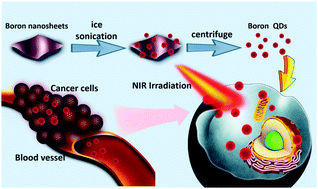Highly efficient photothermal heating via distorted edge-defects in boron quantum dots†
Abstract
Quantum dots (QDs) are increasingly being utilized as near infrared (NIR) active photothermal agents for cancer diagnosis and therapy, with the main emphasis of current research being the enhancement of photothermal conversion efficiencies. Herein, we report the facile synthesis of 2–3 nm boron quantum dots (B QDs), which demonstrated a remarkable photothermal conversion efficiency of 57% under NIR excitation. This outstanding performance can be attributed to the alteration of the electronic structure, which was a result from the distorted edge-effect induced by the unique empty orbit of B atoms in the B QDs. These results can be verified by B K-edge near edge X-ray absorption fine structure (NEXAFS), high-resolution transmission electron microscopy (HR-TEM) and density functional theory (DFT) calculations. The results demonstrate that B QDs represent a promising new and non-toxic agent for both multimodal NIR-driven cancer imaging and photothermal therapy. This work thus identifies B QDs as an exciting new and theranostic agent for cancer therapy. Furthermore, the synthetic strategy used here to synthesize the B QDs was simple and easily scalable.



 Please wait while we load your content...
Please wait while we load your content...